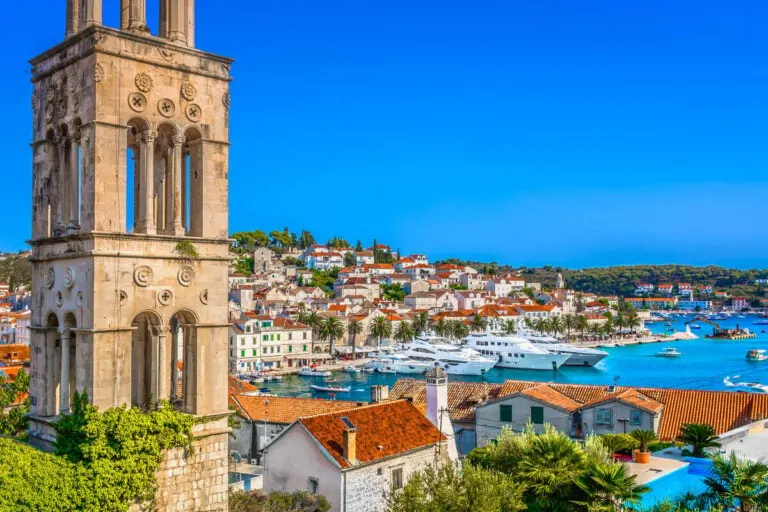If you’re a culture aficionado living in a fairly young country like the United States, where ancient monuments dating back several millennia and charming cobbled towns are extremely rare, if not impossible, to come upon, Europe is likely to be on your travel radar this year.
If you’ve been pondering where to go for that culture-infused spring vacation, allow us to introduce you to this paradise island off the coast of Croatia.
Surrounded by the turquoise waters of the Adriatic Sea, it’s warmer year-round, and you can expect smaller crowds.
Why choose between fairytale castles and the beach when you could have both?
Here’s why trendy, exotic-sounding, Forbes-listed Hvar is a must-visit in 2024:
A Balmy Subtropical Paradise In The Adriatic
Hvar (pronounced ‘For‘) is a Croatian island in the Adriatic, just off the mainland, best known for its ancient heritage and year-round pleasant weather.
With temperatures easily rising to 70°F and higher from April, it is one of the warmest places in Europe in spring.
At only 42 miles long and 6.5 miles at its widest point, it may be a fairly small island, but it has no shortage of manmade and natural landmarks, being home to a pristine coastline interspersed with stone-built towns with origins lost to time and jagged peaks.

If you’re considering flying across the pond for your next spring getaway, culture-based activities are likely to be at the top of your list; in that case, you should know that Hvar is home to some of the oldest settlements in Europe and a surprising concentration of medieval landmarks.
Ancient Towns And A Vibrant Social Scene
The compact capital Hvar Town is a traditional cobbled port dominated by an elevated central fortress, accessible to tourists and offering sweeping views of the maze of winding alleys below, and the bright-blue Adriatic and surrounding Croatian islands beyond.

It is also where a majority of the island’s hotels, guesthouses, restaurants, and tourist facilities are located, including a varied selection of night venues, from laid-back, underground jazz bars to your usual beachfront techno clubs.
Believe it or not, the 10,000-people-strong island has a burgeoning party scene, particularly in the summer months, when holidaymakers from all over Europe flock into the infamous, waterfront Hula Hula Bar for cheap drinks and some dancing.
Unspoiled Coastal Zones And UNESCO World Heritage Sites

Just outside Hvar Town, some of the prettiest swimming spots are Pokonji Dol Beach, a pebbly, yet comfortable beach hugged by the shiniest of waters, Mekicevika, a secluded cove encircled by a pine forest, and trendy Bonj Beach, home to well-frequented Beach Club Hvar.
If you’re craving a deeper dive into the local culture instead, you should take a day trip to Stari Grad, the oldest town on Hvar Island and one of the oldest in all of Europe, having been inhabited for 1,640 years.

Nearby, the Stari Grad Plain is an agricultural field division dating back to Antiquity, and one that remains in use, and relatively intact since Hvar was originally settled. In 2008, it was officially inscribed as a UNESCO World Heritage Site.
Other charming historic sites include Jelsa, a quaint harbor distinguished for its beautiful Romanesque church, Vrboska, a small village with a picturesque canal and a landmark fortified church, and Gdinj, resting on a teal-colored bay.
Affordable Springtime Stays

When it comes to accommodation, there is something in Hvar for every budget and travel preference, from affordable, centrally-located apartments managed by private hosts in Hvar Town for only $79 per night to luxurious resorts with cascading pools, with room rates starting from $336.
In general, Hvar is a relatively affordable destination, like much of Croatia. While there’s no denying prices have been increasing steadily since the country’s accession to the European Union all the way back in 2013, and recently the Eurozone, it’s still cheaper than Italy or Greece.

A one-week trip to Hvar for two people costs on average $1,573, including hotels, food and tourist activities. Naturally, prices fluctuate based on low and high seasons, and you could spend far less visiting in spring, or a lot more in the peak months (June through August).
How To Get To Hvar
Hvar does not host commercial flights – and this arguably helps stem the flow of visitors and keep its Dalmatian character unspoiled for longer – but it is a short ferry ride away from Split, one of the trendiest destinations in the wider Mediterranean, served by a busy international airport.

Split hosts nonstop flights from all over Europe beginning in spring, but there are no Transatlantic flights scheduled just yet.
The easiest way for Americans to get there and transfer onward to Hvar is by flying first into a major European hub like Amsterdam, Frankfurt, Rome, Zurich, or London.
As for the Split-Hvar ferry, the main company operating on this route is called Kapetan Luka – Krilo, and the duration of the journey is around 50 minutes, with tickets for foot passengers ranging between $6.29 and $21.55, depending on the speed of the boat and availability.
Credit: Source link

